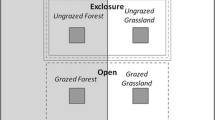Abstract
Experiments with controlled levels of recreational camping were conducted on previously undisturbed sites in two different plant communities in the subalpine zone of the Wind River Mountains, Wyoming, USA. The plant communities were coniferous forest with understory dominated by the low shrub Vaccinium scoparium and a riparian meadow of intermixed grasses and forbs, of which Deschampsia cespitosa was most abundant. Sites were camped on at intensities of either one or four nights per year, for either one (acute disturbance) or three consecutive years (chronic disturbance). Recovery was followed for three years on sites camped on for one year and for one year on sites camped on for three years. Reductions in vegetation cover and vegetation height were much more pronounced on sites in the forest than on sites in the meadow. In both plant communities, increases in vegetation impact were not proportional to increases in either years of camping or nights per year of camping. Close to the center of campsites, near-maximum levels of impact occurred after the first year of camping on forested sites and after the second year on meadow sites. Meadow sites recovered completely within a year, at the camping intensities employed in the experiments. Forest sites, even those camped on for just one night, did not recover completely within three years. Differences between acute and chronic disturbance were not pronounced.








Similar content being viewed by others
References
N. G. Bayfield (1979.) ArticleTitleRecovery of four montane heath communities on Cairngorm, Scotland, from disturbance by trampling. Biological Conservation 15 165–179 Occurrence Handle10.1016/0006-3207(79)90038-7
E. A. Bender T. J. Case M. E. Gilpin (1984) ArticleTitlePerturbation experiments in community ecology: theory and practice. Ecology 65 1–13
D. J. Bogucki J. L. Malanchuk T. E. Schenck (1975) ArticleTitleImpact of short-term camping on ground-level vegetation. Journal of Soil and Water Conservation 30 231–232
D. N. Cole (1987) Research on soil and vegetation in wilderness: a state-of-knowledge review. R. C. Lucas (Eds) Proceedings, national wilderness research conference: issues, state-of-knowledge, future directions. USDA Forest Service General Technical Report INT-220. Intermountain Research Station Ogden, Utah 135–177
Cole, D. N. 1989. Area of vegetation loss: a new index of campsite impact. USDA Forest Service Research Note INT-389, Intermountain Research Station, Ogden, Utah.
Cole, D. N. 1993. Campsites in three western wildernesses: proliferation and changes in condition over 12 to 16 years. USDA Forest Service Research Paper INT-463. Intermountain Research Station, Ogden, Utah.
D. N. Cole (1995a) ArticleTitleDisturbance of natural vegetation by camping: experimental applications of low-level stress. Environmental Management 19 405–416
D. N. Cole (1995b) ArticleTitleExperimental trampling of vegetation. II. Predictors of resistance and resilience. Journal of Applied Ecology 32 215–224
D. N. Cole C. A. Monz (2002) ArticleTitleTrampling disturbance of high-elevation vegetation, Wind River Mountains, Wyoming, U.S.A. Arctic, Antarctic and Alpine Research 34 365–376
D. N. Cole T. P. Hammond S. F. McCool (1997) ArticleTitleInformation quantity and communication effectiveness: low impact messages on wilderness trailside bulletin boards. Leisure Sciences 19 59–72
S. S. Frissell D. P. Duncan (1965) ArticleTitleCampsite preference and deterioration in the Quetico-Superior canoe country. Journal of Forestry 65 256–260
Gniesser, C. H. (2000) “Ecological consequences of recreation on subarctic-alpine tundra: experimental assessment and predictive modeling as planning tools for sustainable visitor management in protected areas.” Dissertation, University of Calgary, AB, Canada
B. Hampton D. Cole (1995) Soft paths: how to use the wilderness without harming it, 2nd ed. Stackpole Books Mechanicsburg, Pennsylvania
J. C. Hendee C. P. Dawson (2002) Wilderness management: stewardship and protection of resources and values, 3rd ed. Fulcrum Publishing Golden, Colorado
S. N. Hurlbert (1984) ArticleTitlePseudoreplication and the design of ecological field experiments. Ecological Monographs 54 187–211 Occurrence Handle1:CAS:528:DyaK2MXjvFemurk%3D Occurrence Handle7750787
Leonard, R. E., J. M. McBride, P. W. Conkling, and J. L. McMahon. 1983. Ground cover changes resulting from low-level camping stress on a remote site. USDA Forest Service Research Paper NE-530, Northeastern Forest Experiment Station, Broomall, Pennsylvania.
Y. Leung J. L. Marion (2000) Recreation impacts and management in wilderness: a state-of-knowledge review. D. N. Cole S. F. McCool W. T. Borrie J. O’Loughlin (Eds) Wilderness science in a time of change—volume 5: wilderness ecosystems, threats, and management. USDA Forest Service Proceedings RMRS-P-15-Vol-5 Rocky Mountain Research Station Ogden, Utah 23–48
M. J. Liddle (1997) Recreation ecology: the ecological impact of outdoor recreation and tourism. Chapman and Hall London
R. Manning N. Ballinger J. Marion J. Roggenbuck (1996) ArticleTitleRecreation management in natural areas: problems and practices, status and trends. Natural Areas Journal 16 142–146
J. L. Marion D. N. Cole (1996) ArticleTitleSpatial and temporal variation in soil and vegetation impacts on campsites. Ecological Applications 62 520–530
J. L. Marion T. A. Farrell (2002) ArticleTitleManagement practices that concentrate visitor activities: camping impact management at Isle Royale National Park, USA. Journal of Environmental Management 66 201–212 Occurrence Handle10.1006/jema.2002.0584 Occurrence Handle12418164
D. Newsome S. A. Moore R. K. Dowling (2002) Natural area tourism: ecology, impacts and management. Channel View Publications Cleveden, UK
K. C. Taylor R. J. Reader D. W. Larson (1993) ArticleTitleScale-dependent inconsistencies in the effects of trampling on a forest understory community. Environmental Management 17 239–248
J. A. Wagar (1964) The carrying capacity of wild lands for recreation. Forest Science Monograph 7. Society of American Foresters Washington, DC
Acknowledgements
The National Outdoor Leadership School and the Aldo Leopold Wilderness Research Institute, Rocky Mountain Research Station, Forest Service, provided financial support. We appreciate the contributions of numerous field assistants, particularly Pat Corry, Lisa Johnson, and Dave Spildie, and help from Jeff Comstock with analysis.
Author information
Authors and Affiliations
Corresponding author
Rights and permissions
About this article
Cite this article
Cole, D., Monz, C. Impacts of Camping on Vegetation: Response and Recovery Following Acute and Chronic Disturbance . Environmental Management 32, 693–705 (2003). https://doi.org/10.1007/s00267-003-0046-x
Published:
Issue Date:
DOI: https://doi.org/10.1007/s00267-003-0046-x




